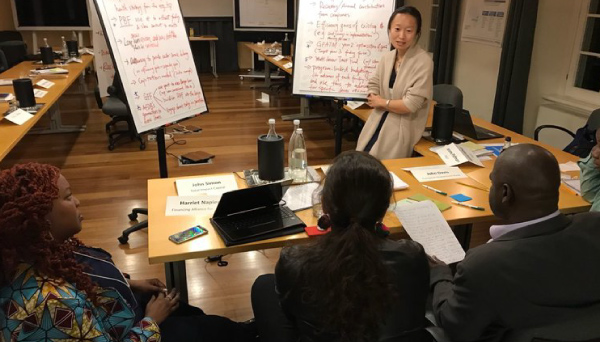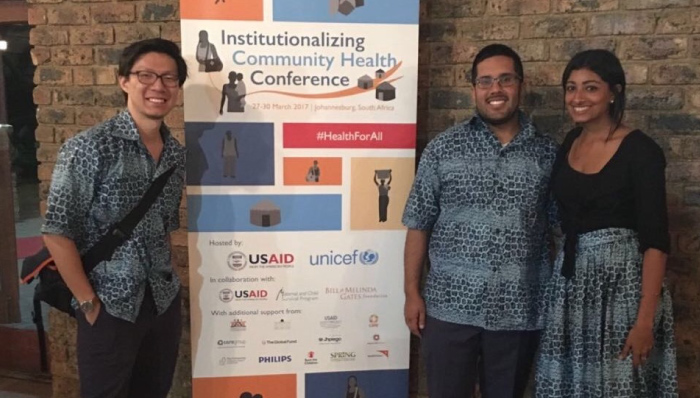Community Health Workers (CHWs) are the backbone of Primary Healthcare (PHC) service delivery in sub-Saharan Africa (SSA). Their pivotal role and tireless efforts in providing essential health services to the most remote communities make them indispensable in achieving Universal Health Coverage (UHC). However, sustaining community health programs and ensuring that CHWs are fully resourced, incentivized, trained, supervised, and supported in their efforts necessitates adequate funding – which remains a formidable challenge.
At Financing Alliance for Health, we partner with governments, donors, and the private sector to address systemic financing challenges to scaling primary healthcare across sub-Saharan Africa. We hosted a webinar on Innovative strategies to sustainably finance primary healthcare, where we were joined by our partners and experts –
- Dr Solomon Matiko Riro, Associate Director of Health Financing, Clinton Health Access Initiative (CHAI)
- Dr Elizabeth Wangia, Director of Health Financing, State Department of Medical Services, Ministry of Health (MoH), Kenya
- Dr Nji Valery Che, Health Financing Technical Advisor, Sierra Leone, Financing Alliance for Health
What is health financing?
Dr Nji Valery Che –
To understand this, I would first go back to establish that health financing is one of the 6-WHO building blocks for health systems. The rest of the building blocks revolve around financing. This means that we need financing to ensure good governance and leadership, to recruit and retain human resources for health, to ensure effective service delivery, to procure medical products, vaccines, and technologies, and to strengthen health information systems. Health financing is made up of 3 sub-functions, namely revenue generation or resource mobilization, revenue pooling and purchasing, or strategic purchasing.
Health Financing is, therefore, defined as a core function of health systems that can enable progress toward universal health coverage by improving effective service coverage and financial protection. The purpose of health financing is to make funding available, as well as to set the right financial incentives for providers to ensure that all individuals have access to effective public health and personal health care. Even when this funding is available, is it largely insufficient; thus, governments are to explore other innovative mechanisms to finance the health system. Most countries have used traditional ways of funding – a large proportion of this has been through external sources/donor funding, which can often be unsustainable and fragmented. The other sources have included domestic funding through out-of-pocket spending/user fees, which are often detrimental and push people into poverty, taxation, social health insurance, community-based health insurance, and private insurance. But health systems in Sub-Saharan Africa (SSA) have faced many financing challenges.
What health financing challenges is Sub-Saharan Africa facing?
Dr Nji Valery Che –
Many countries have limited capacity to raise public revenue mainly because the informal nature of their economies makes collection of taxes and contributions difficult. Most are on average still far from meeting key health financing goals such as the Abuja Declaration target of allocating 15% of the government budget to health. This limits their opportunities for investing in health. The funding gap for health systems in SSA is massive, especially for primary healthcare, and the main role of innovative financing is to fill existing financing gaps, i.e., annual funding gap to achieve SDG (Sustainable Development Goal) 3: “Good health and well-being,” $371 billion for LMICs (Low- and Middle-Income Countries).
What is innovative financing? Can it fill the resource gap?
Dr Nji Valery Che –
The WHO (World Health Organization) task force has defined innovative financing for healthcare as a range of non-traditional mechanisms designed to raise additional funds for health through innovative projects such as micro-contributions, taxes, public-private partnerships, and market-based financial transactions. The main role of innovative financing is to fill existing financing gaps.
But innovative financing is not just about more money; it is also about making existing resources more efficient. The success of innovative financing depends on 4 key criteria – (i) additionality, filling funding gaps, (ii) effectiveness, improving health outcomes, (iii) efficiency, ensuring value for money, and (iv) being transparent and accountable. Some examples of these are sin taxes (excise taxes on harmful goods), social impact bonds, trust and equity funds.
Implementing innovative health financing mechanisms in Africa has long been challenging. However, achieving universal health coverage requires a combination of financing mechanisms on both the demand side (providing financial protection to individuals or households) and supply side (focus on funding healthcare providers and facilities).
In the context of Kenya, how is the government currently financing primary healthcare?
Dr Elizabeth Wangia –
Primary healthcare (PHC) is a current priority for health in Kenya. The Ministry of Health has shifted its focus from largely financing curative care to investing in primary healthcare services. The main goal is to increase access to essential services, improve quality, and ensure sustainable funding for health systems since PHC services are cost-effective and of high impact. Special focus has been made towards investment at the community level i.e., on supporting community health promoters who serve within community health units and report to a link facility. This investment involves the provision of stipends, promoter kits with the necessary equipment, and phones for data collection.
The Kenyan health system is financed from various sources, including donor funding, tax-based financing (Primary Healthcare Fund and emergency, chronic, and critical illness fund – within the social health authority), and Social Health Insurance, which is contributory in nature from employers and households. Other approaches that have been deployed in the past include Performance-Based Financing, Sin-taxes, Public-Private Partnerships, Health Impact Bonds, and Telehealth services.
Have these innovative strategies been successful in Kenya?
Dr Elizabeth Wangia –
Health systems are complex yet adaptive. Each strategy has its own benefits and challenges, and the context in which they are implemented is very important.
The Primary Healthcare Fund, for example, is set up to purchase services from PHC facilities, and patients can only receive services at secondary facilities if they are referred by primary care facilities. Providers will be paid in a way that incentivizes them to deliver better services, likely through methods such as capitation (a fixed payment per patient). While this is considered ideal for financing PHC services, it also has drawbacks. To address the limitations of capitation, the current approach involves a combination of payment methods, i.e., pre-financing a portion of the capitation, additional payments for treating certain illnesses, and including a pharmacy package.
Another approach is Social Health Insurance, which is a financing modality and might not be innovative given the criteria of an innovative financing mechanism. It is a mandatory system wherein individuals, employers, governments contribute to a collective pool which covers secondary healthcare services, typically accessed after referral from primary facilities, ensuring financial protection and access to necessary care. On the other hand, Performance-Based Financing (PBF) ties funding to healthcare provider performance, particularly in areas like Reproductive, Maternal, Newborn, Child, and Adolescent Health (RMNCAH). PBF incentivizes providers to meet specific targets, such as vaccination rates or maternal care services. However, in these initiatives, there have been concerns about data manipulation when reporting impact and the sustainability of this approach.
There have been other more recent approaches, like Public-Private Partnerships (PPPs), that involve collaboration between the public and private sectors in healthcare with the aim of getting private investment and expertise to improve infrastructure and service delivery. Additionally, in Kenya, sin-taxes have been implemented but not specifically for health, and telehealth has also shown good results in pilot facilities, supported by partners by improving access to primary healthcare, especially in remote areas. There’s a lot of potential to explore this further and collaborate with stakeholders to optimize and implement these strategies.
What about non-state actors? How do they play a role in innovative financing for Primary Healthcare?
Dr. Solomon Matiko Riro –
Innovative financing does not always involve dollars changing hands; it is often about efficiency gains that come alongside resource mobilization and purchasing reforms geared towards improving quality and access to healthcare. This is possible through partnerships and collaboration with the non-state actors. These actors include not just private sector entities but also research institutions and non-profit organizations, which can play a critical role in resource mobilization for primary health care, which forms the foundation for UHC.
Non–state actors play a key role in various areas – advocacy and policy influence, as well as partnerships and collaboration. This is not limited to the rigid definition of Public-Private partnerships (PPPs), but goes beyond that. They also play a big role in capacity building, innovation and technology transfer, in addition to building innovative funding solutions.
Are there any successful country cases we can learn from?
Dr. Solomon Matiko Riro –
While there is often a low uptake of PPPs in the content due to legislative gaps among other reasons, collaboration between these sectors is vital to overcome financing challenges in LMICs. One example of a successful partnership is that of Malawi, where the government contracts the Christian Health Association of Malawi (CHAM) facilities at the district level, with the goal of improving access to healthcare.
In addition to this, there are governments in the region that are considering Social Impact Bonds as a mechanism to mobilize resources for the health sector. This is where private entities invest in specific health goals with the expectation of achieving measurable social impact. Kenya recently launched a social impact bond with the goal of improving access to sexual and reproductive health services for the adolescent. Ethiopia recently designed a diaspora bond for infrastructure investments. Though not directly to the health sector, this can serve as a case study to explore.
Mobile health savings and insurance platforms are a great approach to improve access to healthcare financing, and we have seen examples across SSA. Digital technologies have facilitated healthcare payments and expanded insurance coverage, particularly in regions with limited access to financial services. And finally, faith-based organizations also play a role in supporting healthcare funding efforts and ensuring access to essential services in remote areas.
What are some of the tips for scaling up and building sustainable financed health systems?
Dr. Solomon Matiko Riro –
To sustainably finance healthcare systems, we need clear policies and strong partnerships along with a conducive policy environment. Most importantly, we need to have a clear understanding of what PHC means and align on the goals, especially when involving different actors – public or private sector, which are key to financing healthcare better.
Using data wisely is crucial, too, and we should make decisions based on data, but sometimes it’s hard to get good quality data, especially in places with limited resources. Community support is often overlooked, but engaging communities and earning their trust is fundamental; it really makes a difference in successful health programs.
Dr. Elizabeth Wangia –
Health systems are complex yet adaptive, and tailoring strategies to the local context is key. In addition, collaboration and partnerships are critical to sustainably finance primary healthcare, but it is also important for partners to align their goals with those of the government and local context to prevent overlap and maximize impact.
As Dr Matiko said, evidence generation and documentation are key for the success of any approach. And finally, it is not only about the dollars but also efficiency gains which can be achieved through avoidance of wastage and strategic purchasing of Primary Healthcare services.
__________________________________________________________________
As the Financing Alliance for Health, our goal is to pioneer innovative solutions to effectively invest in Primary Healthcare (PHC) across sub-Saharan Africa (SSA). Community Health Workers (CHWs) play a crucial role in delivering essential health services to remote areas, but securing sustainable funding for their efforts remains a significant challenge. By uniting governments, donors, and non-state actors, we can tackle systemic financing barriers and ensure CHWs receive the support they need to thrive.
In SSA, health financing encounters various obstacles, such as limited public revenue and fragmented funding sources. Nonetheless, innovative financing mechanisms offer potential solutions, using unconventional methods like healthcare funds, social impact bonds, PPPs, and telehealth to bridge existing funding gaps. Success hinges on ensuring these approaches are additional, effective, efficient, and transparent. By drawing insights from successful initiatives in countries like Kenya and prioritizing evidence-based decision-making, we can tailor financing strategies to local contexts and establish sustainable, scalable healthcare systems that pave the way for universal health coverage in SSA.
Authored by: Shivani Shukla, Country Investment and Knowledge Analyst & Joseph Gakoi Senior Fellow, Country Investments and Knowledge




